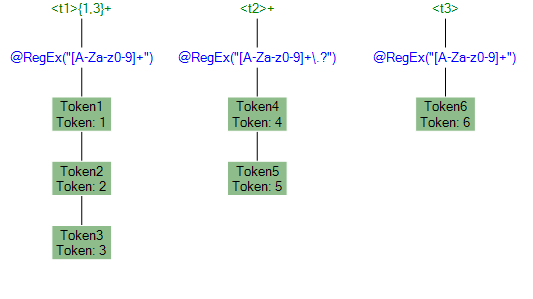Expression Quantifiers: Greedy, Reluctant, and Possessive Behavior
By default, quantifiers are greedy. Greedy means that the expression accepts as many tokens as possible, while still permitting a successful match. You can override this behavior by appending a '?' for reluctant matching or '+' for possessive matching.
Reluctant matching means that the expression accepts as few tokens as possible, while still permitting a successful match.
Possessive matching means that the expression accepts as many tokens as possible, even if doing so prevents a match.
- One or More Quantifier Example
Greedy

- The Greedy behavior in <Field1> accepts the maximum number of tokens that match the rule, while giving up tokens only when necessary to match the remaining rules.
- <Field2> can only accept the minimum number tokens that <Field1> is forced to give up.
- <Field3> can only accept a single token that <Field1> is forced to give up.
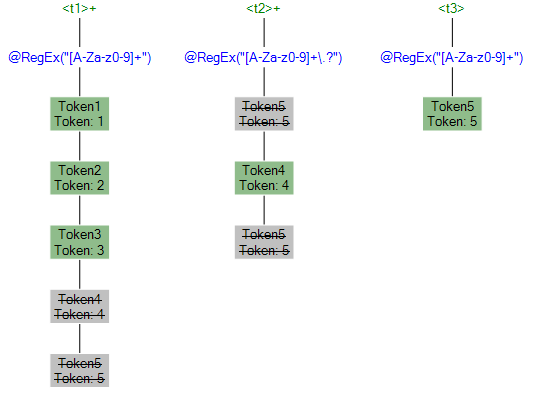
Reluctant

- The reluctant behavior in <Field1> accepts the minimum number of tokens that match the rule while giving up tokens only when necessary to match the remaining rules.
- Because <Field2> is greedy, it accepts the maximum number of tokens given up by <Field1>, while giving up tokens only when necessary to match the remaining rules.
- <Field3> can only accept a single token that <Field2> is forced to give up.
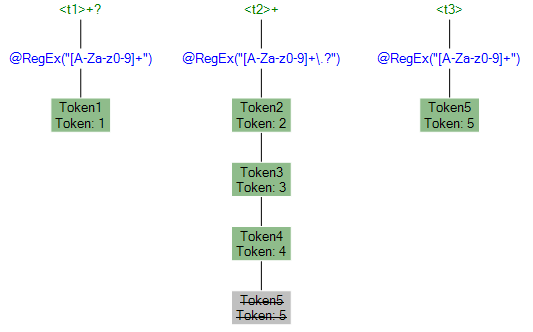
Possessive
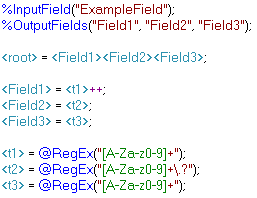
- The possessive behavior in <Field1> accepts the maximum number of tokens that match the rule, while not giving up any tokens to match the remaining rules.
- Because <Field1> is possessive, there are no tokens available for <Field2>. 3. Because <Field1> is possessive, there are no tokens available for <Field3>.
- The input is not parsed.
Zero or More Quantifier Example
Greedy
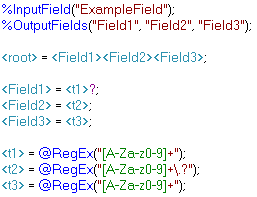
- The Greedy behavior in <Field1> accepts no tokens or the maximum number of tokens that match the rule, while giving up tokens only when necessary to match the remaining rules.
- Because <Field1> is greedy, <Field2> only accepts the minimum number tokens that <Field1> is forced to give up. Since the minimum for <Field2> is zero, zero tokens match this rule.
- Because <Field1> is greedy, <Field3> only accepts a single token that <Field1> rule is forced to give up.
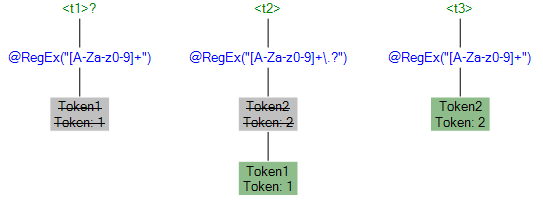
Reluctant
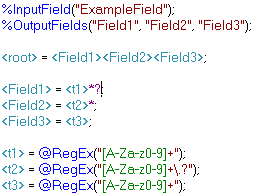
- The reluctant behavior in <Field1> accepts no tokens or the minimum number of tokens that match the rule while giving up tokens only when necessary to match the remaining rules.
- Because <Field2> is greedy, it accepts the maximum number of tokens given up by <Field1>, while giving up tokens only when necessary to match the remaining rules.
- <Field3> can only accept a single token that <Field2> is forced to give up.
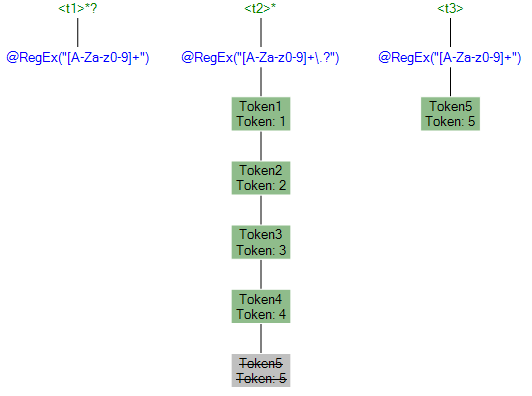
Possessive
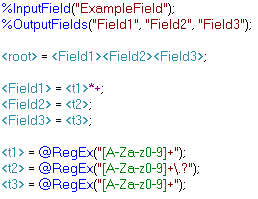
- 1. The possessive behavior in <Field1> accepts no tokens or the maximum number of tokens that match the rule while not giving up any tokens to match the remaining rules.
- Because <Field1> is possessive, there are no tokens available for <Field2>.
- Because <Field1> is possessive, there are no tokens available for <Field3>. The input is not parsed.
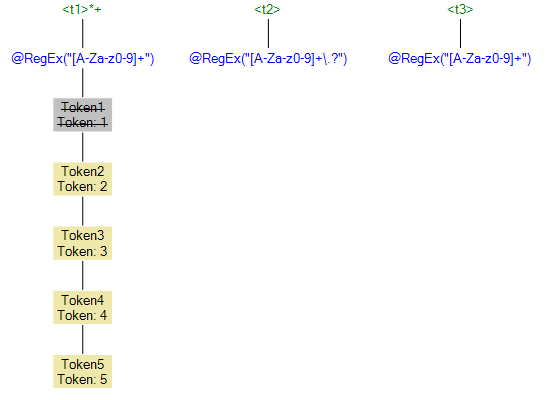
Zero or One Quantifier Example
Greedy

- The Greedy behavior in <Field1> accepts no tokens or the maximum number of tokens that match the rule, while giving up tokens only when necessary to match the remaining rules.
- <Field2> can only accept the minimum number tokens that <Field1> is forced to give up.
- <Field3> can only accept a single token that <Field1> is forced to give up.

Reluctant
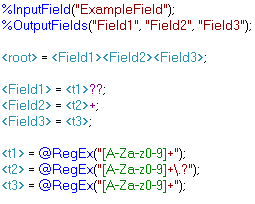
- The reluctant behavior in <Field1> accepts the minimum number of tokens that match the rule while giving up tokens only when necessary to match the remaining rules.
- Because <Field2> is greedy, it accepts the maximum number of tokens given up by <Field1>, while giving up tokens only when necessary to match the remaining rules.
- <Field3> can only accept a single token that <Field2> is forced to give up.
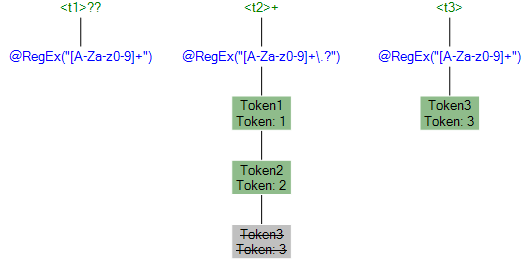
Possessive

- The possessive behavior in <Field1> accepts no tokens or the maximum number of tokens that match the rule, while not giving up any tokens to match the remaining rules.
- Because <Field1> is possessive, there is only one token available for <Field2>.
- Because <Field1> is possessive, there are no tokens available for <Field3>. The input is not parsed.

- Min/Max Quantifier Example
Greedy
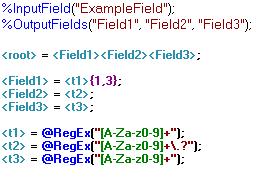
- The Greedy behavior in the <Field1> rule accepts the maximum number of tokens that match the rule, while giving up tokens only when necessary to match the remaining rules.
- <Field2> can only accept the minimum number tokens that <Field1> is forced to give up.
- <Field3> can only accept a single token that <Field1> is forced to give up.
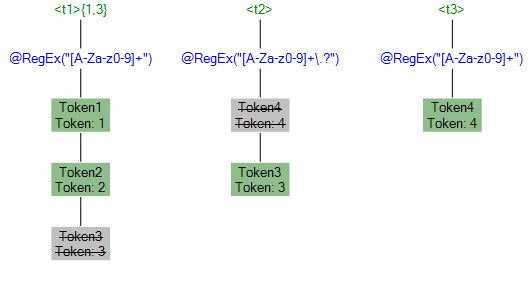
Reluctant
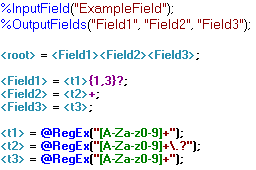
- The reluctant behavior in <Field1> accepts the minimum number of tokens that match the rule while giving up tokens only when necessary to match the remaining rules.
- Because <Field2> is greedy, it accepts the maximum number of tokens given up by <Field1>, while giving up tokens only when necessary to match the remaining rules.
- <Field3> can only accept a single token that <Field2> is forced to give up.
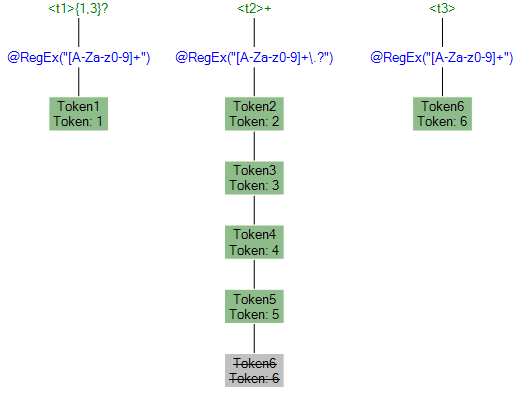
Possessive

- The possessive behavior in <Field1> accepts the maximum number of tokens that match the rule, while not giving up any tokens to match the remaining rules.
- Because <Field1> is possessive, there are two tokens available for <Field2>.
- <Field3> can only accept a single token that <Field2> is forced to give up.
